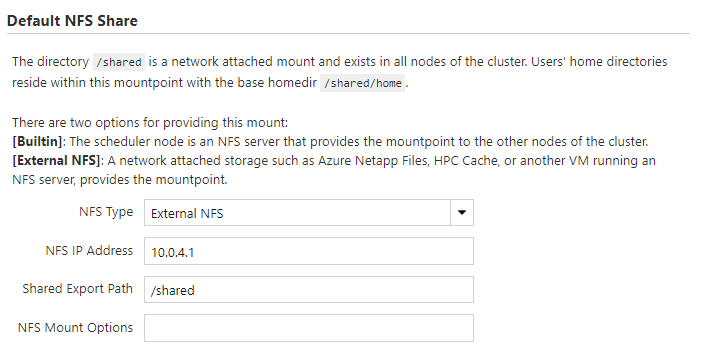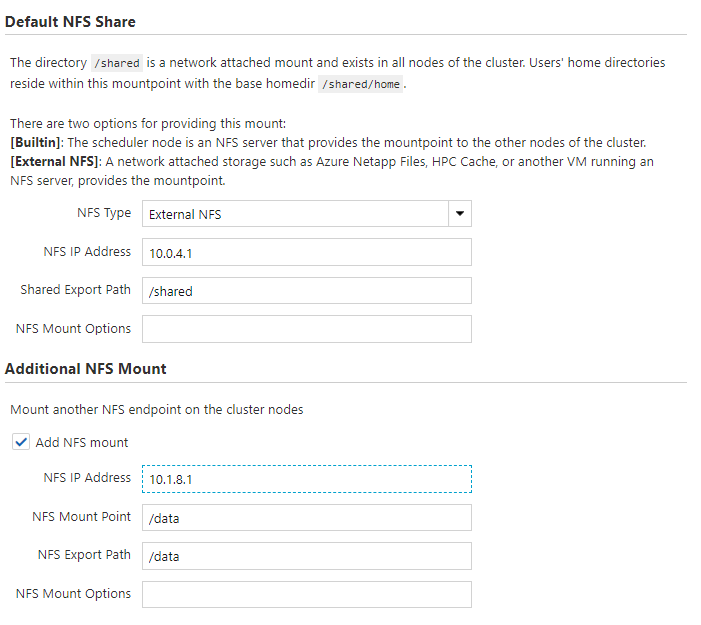Configure NFS Mounts
Azure CycleCloud provides built-in support for mounting a simple Network File System (NFS). The NFS can be another resource managed by CycleCloud or an external resource.
Default Templates - Network Attached Storage Settings
The default cluster templates for each scheduler includes a section for configuring NFS options when creating a clsuter.

The /shared/ directory for each cluster is an NFS share by default. The NFS Type dropdown in this configuration section provides options for this NFS share to be either exported from the cluster headnode (the Builtin option), or mounted from an NFS server.
If Builtin is selected, the NFS share is created on a Azure Managed Disk(Standard SSD) mounted onto the headnode of the cluster, and the Size option specifies the size of the provisioned disk.
Alternatively, if the External NFS option is specified, additional fields appear for specifying the IP address (or hostname) of the NFS server, as well as other NFS mount options. This External NFS option can be used to mount endpoints such as NFS on Azure Files Storage, Azure HPC Cache, Azure NetApp Files, or NFS on Azure Blob Storage.

If another NFS mount point is required, for example as a /data resource for all users, selecting the Add NFS Mount option brings up additional fields add another mount.

Mount an NFS Filesystem
To mount an existing NFS filesystem:
[[[configuration cyclecloud.mounts.nfs_data]]]
type = nfs
mountpoint = /mnt/exports/nfs_data
export_path = /mnt/exports/data
The export_path is the path on the server, and the mountpoint is the path to mount the share on the client. The mounted NFS filesystem may be exported from a node in the same CycleCloud cluster, exported from a node in another CycleCloud cluster, or a separate NFS filesystem that allows simple mounts. If the filesystem is exported from a node in the local cluster, then CycleCloud will use search to discover the address automatically. If the filesystem is exported from a different CycleCloud cluster, then the mount configuration may specify attribute cluster_name to instruct CycleCloud to search the cluster with that name:
[[[configuration cyclecloud.mounts.other_cluster_fs]]]
type = nfs
mountpoint = /mnt/exports/other_cluster_fs
export_path = /mnt/exports/data
cluster_name = filesystem_cluster
To specify the location of the filesystem explicitly (required for mounting non-CycleCloud filesystems), the mount configuration may specify the attribute address with the hostname or IP of the filesystem:
[[[configuration cyclecloud.mounts.external_filer]]]
type = nfs
mountpoint = /mnt/exports/external_filer
address = 54.83.20.2
Default Shares
By default, most CycleCloud cluster types include at least one shared drive mounted at /shared and /mnt/exports/shared. For clusters that need a simple shared filesystem, this mount is often sufficient.
Many cluster types also include a second NFS mount at /sched and /mnt/exports/sched which is reserved for use by the chosen scheduler. In general, this mount should not be accessed by applications.
The mount configurations for the default shares reserve filesystem names cyclecloud.mounts.shared and cyclecloud.mounts.sched. Modifying the default configurations for these shares is possible, but may result in unexpected behavior since many cluster types rely on the default mounts.
Disabling NFS Mounts
Azure CycleCloud NFS mounts may be disabled by setting the disabled attribute to true. The default shares may also be disabled this way:
[[[configuration]]]
cyclecloud.mounts.sched.disabled = true
cyclecloud.mounts.shared.disabled = true
cshared.server.legacy_links_disabled = true
Many clusters assume a shared storage device to be available cluster-wide at /shared. Therefore if you use these configurations enable a fileserver and mount it on each cluster node with:
[[[configuration cyclecloud.mounts.external_shared]]]
type = nfs
mountpoint = /shared
export_path = /mnt/raid/export
address = 54.83.20.2
Mount an Azure Managed Lustre Filesystem
Azure CycleCloud clusters have built-in support for mounting Azure Managed Lustre.
To create a new Azure Managed Lustre Filesystem (AMLFS) for use in your cluster, follow the AMLFS documentation.
To mount an existing AMLFS:
[[[configuration cyclecloud.mounts.lustre_data]]]
type = lustre
address = 10.4.0.14
mountpoint = /lustre_data
The required address attribute specifies the the hostname or IP of the AMLFS.
The required mountpoint attribute specifies the path to mount the AMLFS on the cluster nodes.
Optionally, you may use the export_path attribute to mount existing sub-directories within the AMLFS. For a newly created AMLFS, the only existing path will be /. If export_path is not set, it will default to tcp:/lustrefs/ (AMLFS mount points must be prefixed with tcp:/lustrefs)
For example, assuming the path /data has been created in your lustre filesystem, you can mount data as follows:
[[[configuration cyclecloud.mounts.lustre_data]]]
type = lustre
address = 10.4.0.14
mountpoint = /lustre_data
export_path = tcp:/lustrefs/data/
options = noatime, flock
The optional options attribute may be used to add mount options for an AMLFS mount. options defaults to noatime, flock if not specified.
[!NOTE] Lustre performs best if nodes unmount prior to shutdown, so it is strongly recommended to enable Termination Notifications for nodes which will mount an AMLFS filesystem. CycleCloud will register a shutdown script to cleanly unmount the filesystem upon node termination that will be called if Termination Notifications are enabled.
Mount Configuration Options
| Option | Definition |
|---|---|
| type | REQUIRED The type attribute must be set to nfs for NFS mounts or lustre for AMLFS mounts to differentiate from volume mounts and other shared filesystem types. |
| export_path | The location of the export on the remote filesystem. The export_path must already exist on the remote filesystem. If an export_path is not specified, the mountpoint of the mount will be used as the export_path. |
| mountpoint | The location where the filesystem will be mounted after any additional configuration is applied. If the directory does not already exist, it will be created. |
| cluster_name | The name of the CycleCloud cluster which exports the filesystem. If not set, the node's local cluster is assumed. |
| address | The explicit hostname or IP address of the filesystem. If not set, search will attempt to find the filesystem in a CycleCloud cluster. |
| options | Any non-default options to use when mounting the filesystem. |
| disabled | If set to true, the node will not mount the filesystem. |
Note
Changing the hostname scheme is not supported for most schedulers.